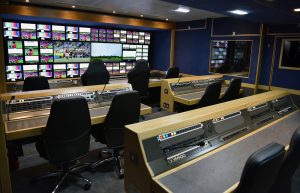SVG Europe Sit-Down: Videlio Media’s Malcolm Robinson on the impact of remote production and IP technology

Malcolm Robinson, operations director, Videlio Media
Videlio designs and deploys video solutions and services for private and public companies in France and around the world. By watching the markets, Videlio anticipates current and future demands, studies them, interprets them and puts forward global solutions for easy and optimal use. Our Sit Down with operations director Malcolm Robinson began by looking at the challenges ahead…
What do you see as your biggest challenges for the next year?
Helping our clients understand what advantages new technology offers, and how best to use that technology to bring efficiencies and new workflow practices.
The emergence of ST2110 as the new standard for broadcasters introduces both challenges and opportunities. We see many companies having delayed important upgrades or new project in anticipation of ST2110 and now the standards are being approved we expect broadcasters to start to introduce these new technologies.
For us, we see two challenges. First, customers’ IP knowledge – a big challenge is ensuring that customers are able to use their existing maintenance teams to service the newly installed system. Luckily, this is an opportunity for Videlio, which has a number of courses focused on training such team members on this important technology.
And secondly, interoperability. Whilst the purpose of ST 2110 is to ensure that systems are interoperable, like the early days of MXF there are many differing interpretations of the standards which can lead to interoperability issues. Again, we see this as an opportunity for our IP specialists to support the customer building multi-vendor solutions.
How has the increase in remote production impacted your business?
Remote production is nothing new to the industry, with many customers already using fibre connections to transmit A/V and data signals between sites.
The emergence of IP and visually lossless codecs has offered new ways to remotely produce, but we see the uptake of this technology as being slow. Primarily this is due to the relatively expensive cost of WAN/point-to-point links and the slow standardisation process for these IP technologies.
Budget considerations are also high as predominantly broadcasting tier 3 type sports is the driving force behind the growth in remote production. It’s about having the content accessible, not revenue or return on investment.
Only an SI of our expertise can offer a fully considered flexible solution for remote production, be it as an MPU (flight cased mobile production unit), or in a small vehicle.
What impact has the expansion of IP technology had on your business?
IP really is our area of focus moving forward and a consideration for most broadcasters we speak to. Videlio was involved in the early implementations of both Arena and Canal+ full IP solutions when using ST2022-6 and who are now moving to ST2110. This allowed us to gain valuable experience early on with some of the difficulties and opportunities of using such a technology.
Videlio had to make an investment in IT specialists who took their IT skills and transferred their knowledge into the broadcast market. We also have formed a specialist relationship with Cisco and other switch manufacturers in order to draw on their experience for projects.
IP brings flexibility, scalability, reliability and future proofing to both existing and new builds, IP cannot be ignored and has to be considered by all in the industry.
After the BBC streamed the World Cup in HDR, is there a bigger appetite for this technology on a wider scale – especially as many viewers will see a bigger uplift from HD to HDR, than from HD to 4K?

Arena TV’s OB X provides Premiership coverage
HDR is indeed very impressive and Videlio has seen a marked increase in broadcasters willing to invest in HD HDR solutions instead of the 4K HDR alternative.
We believe this is primarily down to cost implications of 4K production, which is still at a premium and the production restrictions [of] this technology – limited processing, and so on.
Furthermore, there is a realisation within the industry that HD HDR offers a much better end-user experience, with less disruption to existing infrastructures and less cost.
With regards to all of this technology, are there different levels of take up across different European markets? If so, what do you think is the reason?
Like any new technology, differing European markets are driven by the demands of the end-user, current state of technology, transmission infrastructure, and general wealth of the broadcasters. HD is still very much alive [and] will remain so for a long time until IP standardisation and technology reduces the complexity and price for 4K productions. In the meantime, end-users can enjoy HDR production with minimal cost to the producers.
As far as equipment is concerned, what are you hoping will come out of IBC with the ‘wow’ factor?
Videlio is following the trend of broadcasters to use more data analytics and automated systems – including AI and machine learning – to produce more targeted content with fewer staff.
We are looking forward to seeing the latest technologies that allow for broadcasters to gain better interaction with their audiences, which allow them to better tailor their content.
We can see software defined production, virtualisation, as the big thing at IBC this year and further development of native IP solutions.
Can you share with us a sports related case study that illustrates your innovative use of your services?
2017/2018 saw the introduction of OB 12 into the Arena TV fleet of vehicles. This presentation vehicle works alongside OB X providing Premiership coverage and was the first time that two full IP based vehicles worked in a full IP environment. 16 x 40Gb fibres connecting the two vehicles together…this is the future of OB rigging!

